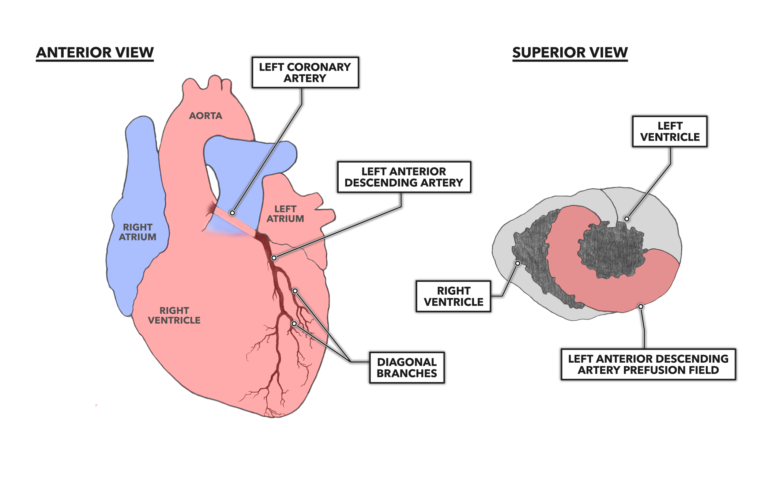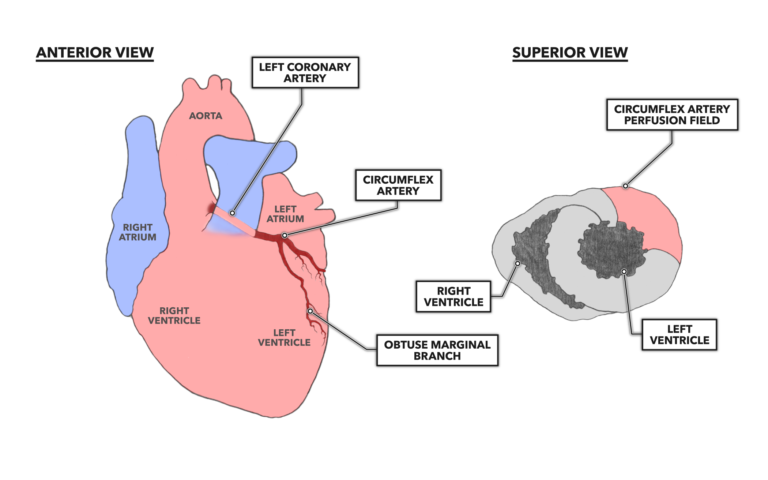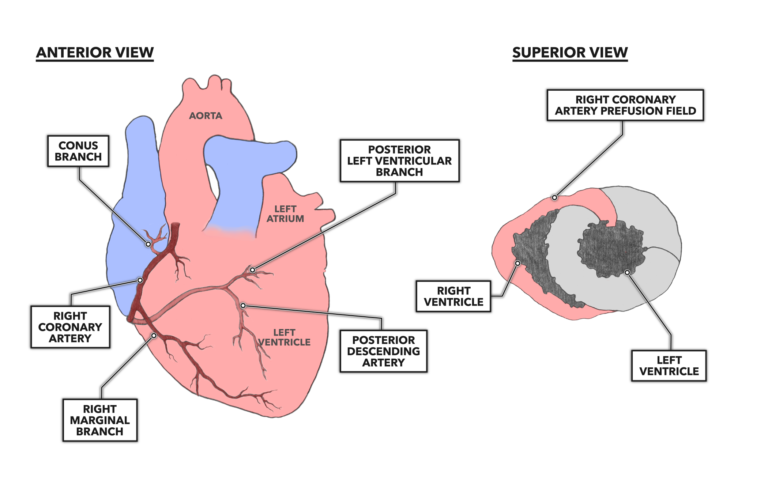Coronary circulation includes important arteries and veins that perfuse the heart. The blood inside the atria and ventricles does not directly support the heart muscle; the heart has to deliver and drain blood as it does for any other muscle. However, these arteries and veins represent a site-specific network. The right and left main coronary arteries diverge from the aorta as soon as the aorta emerges from the cardiac mass, and they then spread out along the surface of the heart, with vessels dividing and penetrating down into the heart to provide extensive blood flow to all parts of this essential muscle.
These arteries divide into a left and right side. A left common coronary artery emerges from the aorta and divides into the left anterior descending coronary artery and the left circumflex coronary artery. The anterior descending artery runs down the front of the left ventricle. The circumflex artery runs around the superior aspect of the left ventricle — anterior to posterior — just below the atrial juncture. Both of these arteries branch extensively to feed the left side of the heart.

Figure 1: The elements of the left anterior descending coronary artery (left). Note this image depicts surface vessels; there is significant branching and penetration of offshoots of these vessels throughout the myocardial muscle. The image on the right estimates the perfusion field fed by the left anterior descending coronary artery and its downstream divisions.

Figure 2: The elements of the circumflex coronary artery (left). The image on the right estimates the perfusion field fed by the circumflex artery and its downstream divisions.
The right side of the coronary circulation is slightly less extensive. The right common coronary artery emerges from the aorta and runs anterior to posterior along the right superior surface of the right ventricle just below the right atria. This coronary artery divides extensively into several branches and into the right posterior descending artery to perfuse the right side of the heart.

Figure 3: The elements of the right coronary artery (left). The image on the right estimates the perfusion field fed by the right coronary artery and its downstream divisions.
The venous circulatory elements are much easier to remember: greater cardiac vein, middle cardiac vein, and the small cardiac vein. All merge and empty into the coronary sinus, an input into the right atrium. The greater cardiac vein follows along with the left anterior descending and circumflex elements of the left coronary artery tree. The middle cardiac vein associates with the right coronary artery tree, wrapping around to include the posterior descending artery. The small cardiac vein also follows the right coronary artery tree but traces down along the acute marginal branch of the right coronary artery. There is little attention given to these components of the coronary vasculature, as it is exceedingly rare for them to be diseased.
Coronary Circulatory Malfunction
Blockage of coronary arterial blood flow, partial or complete, carries a negative health outcome. The most common cause of blockage in these arteries is atherosclerosis, the major coronary artery disease. A little over one-third of all cardiovascular-related deaths are the result of coronary artery disease. According to the Centers for Disease Control and Prevention, there were 365,914 such deaths in 2017 in the U.S. This was approximately 0.1% of the total population (1 in 1,000 people). This is a significant medical and social expense, and a great deal of effort and funding have been directed toward reducing the rate of mortality associated with coronary artery disease. Of specific interest to trainers and coaches is the demonstrated relationship between exercise and coronary artery disease: Continually active individuals are far less likely to develop atherosclerosis over their lifespan.
One thing that is certain is that every coach or trainer will work with someone, or many people, with atherosclerosis. Having a functional knowledge of first aid and an established emergency plan as well as maintaining continual surveillance on all athletes during exercise is a necessity for fitness professionals.